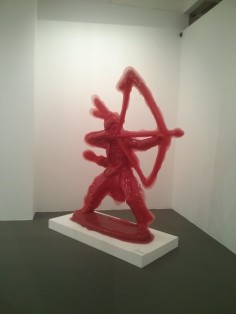Yoram Wolberger
Red Indian #4 (Spearman)
source: markmooregallery
Yoram Wolberger uses childhood toys and everyday domestic items to create his large scale sculptures, foregrounding the latent symbolism and cultural paradigms of these objects that so subtly inform Western culture. By enlarging this ephemera to life size, Wolberger emphasizes the distortions of their original manufacture disallowing any real illusion and conceptually forcing the viewer to reconsider their meanings. When enlarged beyond any possibility of dismissal, we see that toy soldiers create lines between Us and Them, plastic cowboys and Indians marginalize and stereotype the Other, even wedding cake bride and groom figurines dictate our expected gender roles.
Wolberger (b. 1963, Tel Aviv, Israel) earned his MFA from the San Francisco Art Institute’s (CA) New Genres Department. He has had solo exhibitions in New York, Los Angeles and San Francisco, and has been featured in group exhibitions at the Brooklyn Museum of Art (NY), deCordova Sculpture Park (MA), the Aldrich Contemporary Museum (CT), Orange County Museum of Art (CA), Museum of Contemporary Art (IL) and the Israeli Museum of Modern Art (Israel) among others. His works have been acquired for the permanent collections of the Brooklyn Museum of Art (NY), Frederick R. Weisman Foundation (CA), the Orange County Museum of Art (CA), Sweeney Art Gallery, University of California Riverside (CA) and the McNay Art Museum (TX). The artist lives and works in San Francisco, CA.
.
.
.
.
.
.
.
.
source: bcontemporary
Wolberger’s art manipulates and challenges perceptions of the familiar through a variety of sculptural interventions. He often chooses to work with everyday, culturally iconic, objects to which we attach deep-seated and often unconscious meanings. Transformed beyond their original context, these objects suggest new associations and provoke fresh insights into their larger societal relevance and influence.
Cowboys & Indians is based on the widely familiar toy figurines with which Wolberger played during his youth, and invites viewers to consider the manufacturing of common cultural stereotypes. Faithfully reproducing the seemingly innocent figurines at life size proportions with all their original design “flaws” intact, the artist compels us to reexamine the cultural attitudes implied by such distorted portrayals.


